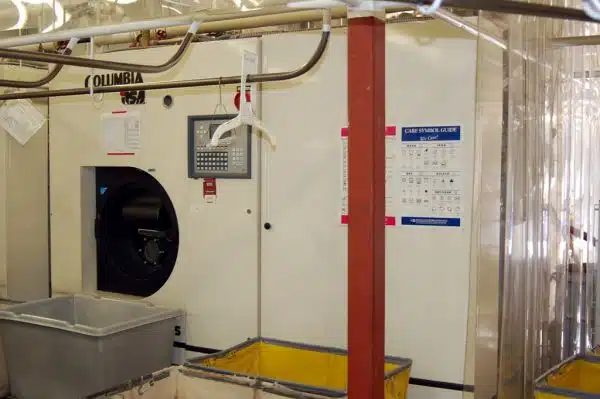As a dry cleaning professional, it is essential to understand the proper usage of dry cleaning solvents. Dry cleaning solvent is a chemical substance used to remove stains and dirt from fabrics that cannot withstand water immersion. Solvent-based cleaners are popular for their effectiveness in removing oil-based stains and grease from delicate fabrics.
Dry cleaning solvents are known to be hazardous if not used correctly. Ignorance or carelessness when handling these chemicals could lead to severe health hazards. As such, it is vital to have extensive knowledge about the appropriate use of dry cleaning solvents before embarking on any task that involves them. In this article, we will explore how to properly use dry cleaning solvent and some tips on how to ensure safety while doing so.
Understanding Dry Cleaning Solvents
Dry cleaning solvent is a chemical solution used to clean fabrics that cannot be washed with water. These fabrics are often delicate and require special care to avoid damage during the cleaning process. Dry cleaning solvents work by dissolving dirt and oils from the fabric, leaving it clean and fresh.
It is important to understand the effects of dry cleaning solvents on different types of fabrics before using them. Certain fabrics, such as silk and wool, are more delicate than others and may be damaged by harsh solvents. Additionally, some fabrics may shrink or lose their shape if exposed to certain chemicals. Therefore, it is crucial to identify the type of fabric before using any kind of dry cleaning solvent.
Fabrics suitable for dry cleaning solvent include those made from natural fibers such as wool, silk, cotton, and linen. Synthetic fabrics such as polyester and rayon can also be cleaned with dry cleaning solvent. However, it is important to note that not all fabrics are suitable for this method of cleaning and may require alternative methods such as handwashing or professional wet-cleaning services. Understanding which fabrics can be safely cleaned with dry cleaning solvent is an essential first step in ensuring that your clothing stays clean and well-maintained. With this knowledge in mind, let’s move on to explore different types of dry cleaning solvents available in the market today.
Types Of Dry Cleaning Solvents
It is imperative for any dry cleaning professional to know the types of dry cleaning solvents available in the market. Choosing the right solvent can affect not only the quality of cleaning but also its environmental impact. There are two main types of solvents: petroleum-based and synthetic.
Petroleum-based solvents, such as perchloroethylene (perc) and hydrocarbon, have been used in the industry for a long time due to their effectiveness in removing stains and dirt. However, they have some drawbacks. Perc is a known carcinogen and poses health risks to workers who handle it frequently. Hydrocarbon has less toxicity than perc but still emits volatile organic compounds (VOCs) that contribute to air pollution. On the other hand, synthetic solvents like liquid carbon dioxide and GreenEarth offer benefits such as being non-toxic, odorless, and biodegradable. They are also gentler on fabrics, making them ideal for delicate garments.
When choosing a dry cleaning solvent, one must consider not only its effectiveness but also its environmental impact. Petroleum-based solvents emit harmful substances into the air during use and disposal, contributing to air pollution and harming human health. Synthetic solvents offer a safer alternative with their non-toxic properties and biodegradability. Ultimately, as professionals in this field, we must choose wisely to ensure that our work benefits both our clients’ needs and our planet’s well-being.
As responsible dry cleaners, we must take into account both the benefits and drawbacks of each type of solvent before deciding which one to use regularly. Additionally, it is important to follow safety precautions before using any solvent to avoid accidents or injuries that may harm ourselves or others around us. In the next section, we will discuss these precautions in detail so that we can provide high-quality dry cleaning services while keeping everyone safe from harm’s way.
Safety Precautions Before Using Dry Cleaning Solvent
Precautionary measures are essential before using dry cleaning solvent. This is because the solvent is a hazardous chemical that can pose risks to users. To ensure safety, it is crucial to read and follow the manufacturer’s instructions on the container label carefully. Moreover, the room in which the dry cleaning process takes place should be well-ventilated to reduce exposure to toxic fumes.
Environmental impact is another crucial consideration when using dry cleaning solvents. Many of these chemicals are harmful to the environment, especially if they are not disposed of properly. Therefore, it is essential to store and dispose of them as per the local regulations. Additionally, some manufacturers offer eco-friendly alternatives that use biodegradable solvents, which are less harmful to the environment.
To summarize, precautionary measures and environmental impact are vital considerations before using dry cleaning solvents. Users should take necessary precautions such as wearing protective clothing and equipment while handling these chemicals. Environmental responsibility also involves proper disposal of used solvents. By following these guidelines, users can minimize potential risks and prevent harm both to themselves and the environment.
Moving on to protective clothing and equipment, it is essential to wear gloves, goggles, face masks while handling dry cleaning solvents. The skin absorbs many chemicals readily; therefore, direct contact with solvents can cause irritation or burns on exposed skin areas like hands or arms. Protective gear such as aprons or full-body suits can prevent direct contact with clothes soaked in solvent during washing processes. Wearing protective gear provides an extra layer of protection against any accidental spillages or splashes that may occur during use of dry cleaning solvents.
Protective Clothing And Equipment
As a dry cleaning professional, safety is paramount when using dry cleaning solvents. In the previous section, we discussed some safety precautions that must be taken before using these solvents. Now, let us discuss protective clothing and equipment that you must wear while handling these chemicals.
Protective clothing and equipment are essential when working with dry cleaning solvents. The clothes you wear must cover your entire body, including your arms and legs. You should also wear gloves made of neoprene or nitrile to protect your hands from any accidental spills. To protect your eyes from harmful fumes, you should wear goggles or a face shield.
Handling techniques are also important to prevent any mishaps while using the solvent. Always keep the solvent canister closed when not in use, and never transfer it into another container. Additionally, if there is any spillage while handling the solvent, clean it up immediately using a dry cloth or paper towel.
Proper ventilation is crucial when working with dry cleaning solvents. Ensure that your workspace has adequate ventilation to allow for proper air circulation. This will help prevent any buildup of fumes and ensure that you are not inhaling any harmful chemicals while working with the solvent. Remember to always follow these guidelines to ensure safe handling of dry cleaning solvents at all times.
Proper Ventilation
The importance of proper ventilation when using dry cleaning solvent cannot be overstated. Adequate air flow is necessary to ensure that the solvent fumes do not accumulate and become a health hazard. In addition, good ventilation can help to reduce the risk of fire hazards associated with the use of these chemicals.
One of the most effective techniques for achieving proper ventilation is to use an exhaust fan or open windows and doors to allow fresh air into the room. It is also important to avoid working in an enclosed space where fumes can build up quickly. If possible, it may be helpful to set up a work area in a well-ventilated outdoor location.
Another strategy for ensuring proper ventilation is to wear a respirator when working with dry cleaning solvent. A properly fitted respirator can filter out harmful fumes and protect your lungs from damage. However, it should be noted that wearing a respirator does not eliminate the need for good ventilation practices.
In summary, maintaining proper ventilation is crucial when working with dry cleaning solvent to prevent health risks and fire hazards. Use an exhaust fan or open windows and doors, avoid enclosed spaces, consider working outdoors if possible, and wear a respirator if necessary. By following these guidelines, you can ensure a safe and healthy work environment while using dry cleaning solvents.
To further minimize risks associated with dry cleaning solvents, it is important to take steps to avoid fire hazards.
Avoiding Fire Hazards
Are you aware of the fire hazards involved in using dry cleaning solvent? It is crucial to take precautions and follow safe handling techniques to avoid accidents. The use of dry cleaning solvents involves flammable chemicals, which can ignite if not handled properly.
Here are some fire hazards prevention tips that every dry cleaning professional should follow:
Always store the solvent in a cool, dry place away from sources of heat or ignition.
Sub-list 1: Avoid storing the solvent near electrical outlets, heaters or other appliances that generate heat.
Sub-list 2: Keep it away from direct sunlight or any sparks that could cause an explosion.
Do not smoke while handling the solvent or use it near an open flame.
Sub-list 1: Use protective gear such as gloves and goggles when handling the solvent.
Sub-list 2: Ensure proper ventilation in your workspace by opening windows or using exhaust fans.
By following these guidelines, you can prevent fire accidents and ensure a safe working environment. Safe handling techniques are critical in preventing accidents and minimizing risks associated with working with flammable chemicals.
To maintain safety standards, let’s move on to discussing the proper storage of dry cleaning solvent.
Proper Storage Of Dry Cleaning Solvent
Dry cleaning solvent is a hazardous substance that needs to be handled and stored with care. Proper labeling of the containers used for storing dry cleaning solvent is essential to ensure safe handling and transportation. When storing dry cleaning solvent, it is important to keep it away from other chemicals and heat sources.
To properly store dry cleaning solvent, make sure the container is clearly labeled with the name of the substance, as well as any hazard warnings or safety instructions. This will help prevent confusion and accidental exposure. Additionally, when transporting dry cleaning solvent, use a secure container that won’t leak or spill during transit.
Safe transportation of dry cleaning solvent requires careful consideration of potential hazards. Always transport dry cleaning solvent in a sealed container to prevent spills or leaks. If possible, use a separate vehicle for transporting hazardous materials to reduce the risk of accidents involving other drivers on the road. Remember to drive carefully and follow all relevant safety laws and regulations when transporting dry cleaning solvent.
In order to ensure proper handling and disposal of used solvent, it is important to understand how to safely handle this hazardous material. The next section will provide guidance on how to handle and dispose of used dry cleaning solvent in an environmentally responsible way.
Handling And Disposing Of Used Solvent
- Solvents used for dry cleaning should be stored in a cool, dry place that is away from direct sunlight and sources of heat.
- Care should be taken to avoid contact with skin when handling solvents and appropriate protective gear should be worn.
- Solvent containers should be sealed and labeled with the date of disposal and the type of solvent.
- All spent solvents should be emptied and filtered before being disposed of to ensure that all particulates are removed.
- Solvent waste should be collected in approved containers and disposed of in accordance with local regulations.
- Unused solvents should be recycled or disposed of in a manner that is compliant with environmental regulations.
Proper Storage
Dry cleaning solvents are essential for maintaining the quality of delicate fabrics and removing stubborn stains. However, proper handling and disposing of used solvent are equally important to ensure the safety of both customers and employees. Proper storage is a key element in ensuring that the solvent remains effective while being stored safely.
The first step in proper storage is to maintain an appropriate storage temperature. Dry cleaning solvents should be stored at a temperature between 60-80 degrees Fahrenheit. This temperature range ensures that the solvent maintains its effectiveness, while also preventing it from evaporating too quickly or freezing. Additionally, it is crucial to store solvents away from direct sunlight, as exposure can cause the solvent to break down or become less effective over time.
Another important aspect of proper storage is selecting appropriate containers for storing dry cleaning solvents. Glass or metal containers are preferred as they are less likely to react with the solvent, ensuring it remains pure and effective for longer periods. These types of containers also prevent any contamination from occurring. It is crucial to avoid using plastic containers for storing solvents as they may break down due to chemical interactions with the solvent.
In conclusion, proper storage is critical in maintaining the effectiveness of dry cleaning solvents while ensuring safe handling and disposal practices. Maintaining an appropriate storage temperature and selecting suitable containers will help prolong the lifespan of these essential products and keep them fresh for use when needed. By following these guidelines, we can ensure that our customers receive high-quality services while prioritizing their safety and well-being.
Safe Handling
Safe handling of dry cleaning solvents is crucial in ensuring the well-being of both customers and employees. These solvents contain potentially hazardous chemicals that can cause harm if mishandled or improperly disposed of. Therefore, it is essential to establish safe handling procedures to reduce the risk of accidents and injuries.
One important aspect of safe handling is to ensure that employees have proper training on how to handle and use dry cleaning solvents safely. This training should include information on the potential hazards associated with these products, as well as best practices for storing, using, and disposing of them. Employees should also be provided with appropriate personal protective equipment (PPE), such as gloves and goggles, to prevent exposure to the skin or eyes.
Another critical element in safe handling is proper labeling of solvent containers. All containers must be clearly labeled with the name of the solvent, hazard warnings, and any other relevant information. This labeling ensures that employees can identify which solvent they are working with and understand its potential hazards before using it. Additionally, it helps prevent accidental mixing of different solvents, which can result in dangerous chemical reactions.
In conclusion, safe handling practices are essential for maintaining a healthy and safe workplace environment when working with dry cleaning solvents. Proper training and PPE use are crucial steps in reducing the risk of accidents and injuries. Furthermore, clear labeling of containers helps employees identify which solvent they are working with while understanding its potential hazards before using it. By prioritizing safe handling practices, we can ensure that our customers receive high-quality services while protecting our employees’ well-being.
Disposal Methods
Proper disposal of used solvent is crucial in maintaining a safe and healthy workplace environment. Disposing of these solvents improperly can have adverse effects on the environment, including groundwater contamination, air pollution, and soil degradation. As a dry cleaning professional, it is our responsibility to ensure that we dispose of used solvents appropriately to prevent any harm to the environment.
There are several methods for proper disposal of used solvent, including recycling, incineration, or using a hazardous waste disposal service. Recycling involves distilling or purifying the solvent for reuse, reducing the amount of waste generated. Incineration involves burning the solvent at high temperatures to eliminate hazardous substances before releasing it into the atmosphere. Hazardous waste disposal services collect and transport used solvents from businesses for treatment and disposal.
It is essential to consider the environmental impact when choosing a disposal method for used solvents. Recycling and reusing solvents are environmentally friendly options as they reduce waste generation and conserve natural resources. On the other hand, incineration can cause air pollution if not done correctly, while hazardous waste disposal services may require significant energy consumption during transportation. As dry cleaning professionals, we must weigh all options carefully when selecting a disposal method for used solvents that will minimize any negative environmental impact.
Pre-Treating Stains Before Using Dry Cleaning Solvent
Just like how a surgeon preps a patient before surgery, it is crucial to pre-treat stains before using dry cleaning solvent. Think of the stains as wounds that need special attention before they can be properly cleaned. Using pre treatment sprays, such as those containing enzymes or oxygen bleach, can help break down and loosen the stain for easier removal.
However, not all stains can be removed with dry cleaning solvent alone. Alternative stain removal methods may need to be employed before using the solvent. For example, oil-based stains may require a degreaser or solvent-based cleaner before being treated with dry cleaning solvent.
To ensure that the garment is properly and completely cleaned, it is important to choose the right solvent for the fabric. Different fabrics require different types of solvents and failure to use the correct one can lead to discoloration or damage to the material. It is always best to consult with a professional dry cleaner if unsure about which solvent to use for a particular fabric.
Transitioning into the subsequent section about choosing the right solvent for the fabric, it is essential to understand that different fabrics have specific requirements when it comes to cleaning solutions.
Choosing The Right Solvent For The Fabric
Choosing the right solvent for the fabric is crucial in dry cleaning. Different fabrics require different solvents, and using the wrong one could damage the garment or leave it with stains. Generally, there are two types of solvents: petroleum-based and synthetic-based. Petroleum-based solvents are more effective in removing oil-based stains such as grease and motor oil, while synthetic-based solvents are better for water-based stains such as coffee and wine.
Solvent compatibility with different types of stains is also an essential factor to consider when choosing a solvent. Some solvents work better on certain types of stains than others. For example, perchloroethylene, a commonly used synthetic-based solvent, is excellent at removing protein-based stains like blood and sweat. On the other hand, glycol ether is more effective in removing ink and dye stains.
When selecting a solvent, it’s vital to consult the manufacturer’s instructions or seek professional advice from dry cleaning experts. They can provide guidance on which solvent works best for specific fabrics and stain types. By choosing the right solvent for the fabric and stain type, you can ensure that your garments stay clean without any damage or discoloration.
Transition into subsequent section: Now that we’ve discussed how to choose the right solvent for your fabric let’s move on to applying dry cleaning solvent to your garments effectively.
Applying Dry Cleaning Solvent To The Fabric
When using dry cleaning solvents, it is important to select the right product for the fabric type in order to avoid damage. Additionally, the fabric must be prepared for the application of the solvent by ensuring that it is clean, dry, and free of any residue that may interfere with the cleaning process. It is also important to test a small area of the fabric with the solvent to make sure it does not discolor or shrink the fabric. Finally, the solvent should be applied to the fabric in a light and even manner to ensure the best results.
Selecting The Right Solvent
Selecting the right solvent is a crucial step in applying dry cleaning solvent to fabric. It is important to keep in mind the safety of the solvent and its environmental impact. As a dry cleaning professional, it is essential to prioritize the well-being of both clients and the environment.
Solvent safety should be your top consideration when selecting a dry cleaning solvent. Some solvents can be harmful if ingested or inhaled, which could lead to serious health problems. Therefore, it is essential to ensure that the chosen solvent has no adverse effects on human health.
Another critical aspect of selecting a dry cleaning solvent is its environmental impact. Some solvents have significant negative impacts on the environment, including air pollution and water contamination. As such, choosing an eco-friendly and sustainable option is vital in reducing your carbon footprint as well as minimizing hazards to wildlife.
In conclusion, selecting the right solvent for applying dry cleaning solvent to fabric involves prioritizing safety and sustainability while eliminating harm to both humans and the environment. By considering these factors, you can ensure that your dry cleaning business meets ethical standards while providing excellent service to clients.
Preparing The Fabric
Choosing the right fabric is essential in applying dry cleaning solvent to fabric. As a dry cleaning professional, it is crucial to consider the type of fabric and its condition before beginning the cleaning process. Some fabrics may require special care, such as delicate or fragile materials that need extra attention during cleaning. Therefore, selecting the appropriate fabric is critical in ensuring that the final result meets or exceeds customer expectations.
Once you have chosen the appropriate fabric, preparing it for dry cleaning is the next step. Proper cleaning techniques are vital in eliminating stains, dirt, and other particles from the material effectively. Pre-treating stains with a suitable solvent can help loosen and lift any remaining residue before immersing it in dry cleaning solvent. Additionally, using a pre-cleaning process or agitation can help remove any stubborn dirt or debris from the fabric.
After preparing the fabric comes applying dry cleaning solvent to the material. This process involves immersing or spraying a suitable solvent onto the fabric to dissolve and extract any remaining dirt and stains. The duration of this process varies depending on various factors like type of material, soil level, and machine performance. By following these steps carefully and thoroughly during each stage of preparing and applying dry cleaning solvent, you can ensure that your clients receive high-quality service while maintaining ethical standards in your business practice.
Drying And Finishing The Fabric
After the dry cleaning process, it is crucial to properly dry and finish the fabric to prevent any damage or discoloration. The first step is to hang or lay flat the garment in a well-ventilated area until it is completely dry. Avoid exposing it to direct sunlight or high heat as this can cause shrinkage or fading of colors.
Ironing delicate fabrics can be a challenging task, but with some tips, it can be done easily. Firstly, use a low heat setting on your iron and avoid pressing too hard on the fabric. Secondly, always test a small area of the fabric before ironing the entire garment. Lastly, use a pressing cloth between the iron and fabric to prevent any scorch marks or damage.
If you need to remove wrinkles at home without using an iron, there are some best practices you can follow. Start by hanging the garment in a steamy bathroom for about 15 minutes while taking a hot shower. Alternatively, you can use a handheld steamer or spray water onto the wrinkles and then use your hands to smooth them out gently.
Moving forward into common mistakes when using dry cleaning solvent, it is essential to note that improper usage of solvent can lead to damage of the fabric. It is important not to overuse solvent as this may cause discoloration or fading of colors. Additionally, avoid rubbing or scrubbing the fabric too hard during cleaning as this may lead to tearing or fraying of delicate fabrics such as silk or lace.
Common Mistakes When Using Dry Cleaning Solvent
Drying and finishing the fabric is an important step in the dry cleaning process. It’s like putting the cherry on top of a sundae; it completes the look and feel of the garment, making it ready to wear. However, before proceeding to this stage, it is crucial to use the dry cleaning solvent properly.
Common mistakes when using dry cleaning solvent include overusing and improper disposal. Overusing can harm both your clothes and the environment. Too much solvent can break down fabrics, causing them to lose their shape and color. Moreover, improper disposal of solvent can pose serious risks to human health and the environment.
To avoid these mistakes, pre-treating stains is essential. This step helps remove any stubborn stains that may not be removed during normal washing. Choosing the right solvent is also crucial for achieving excellent results in dry cleaning. Different fabrics require different solvents depending on their composition and sensitivity. By following these best practices, you can ensure that your garments remain fresh-looking while protecting yourself and our planet from harmful chemicals.
Troubleshooting issues with dry cleaning solvent requires patience and careful attention to detail. By following best practices, such as pre-treating stains before using a solvent and choosing the right type of solvent for each fabric type, common mistakes like overusing or improperly disposing of solvents can be avoided altogether. If you experience difficulties with your dry cleaning process despite observing these guidelines, seek professional assistance immediately to prevent further damage to your garments or equipment.
Troubleshooting Issues With Dry Cleaning Solvent
Preventing Residue is a crucial aspect of using dry cleaning solvent. One effective way of doing this is by ensuring that the solvent is clear and free from any impurities before use. This can be achieved by filtering the solvent through a clean cheesecloth or coffee filter before pouring it into the cleaning machine. Additionally, it is important to ensure that the solvent used for each batch of clothes is sufficient and not overused. Overusing solvent may lead to residue buildup on clothes, which can be difficult to remove.
Addressing Foul Odors in dry cleaning solvent can be challenging but necessary to ensure that clothes come out smelling fresh and clean. One way to address this issue is by adding odor-eliminating agents such as activated charcoal or baking soda into the solvent mixture before cleaning clothes. Another solution could be to replace the old solvent with a fresher one periodically, especially if it has been sitting unused for an extended period. It’s also essential to store the solvent in an airtight container or drum to prevent contamination by air-borne odors.
Maintaining Dry Cleaning Equipment is vital in prolonging its lifespan and ensuring optimal performance. Regularly inspecting hoses and connections for leaks, worn-out parts, and damages can prevent accidents and equipment failure during operation. Cleaning filters after every use also helps keep equipment running smoothly while maintaining efficiency. Additionally, keeping equipment dry after every use eliminates moisture retention, which prevents rusting and corrosion that might damage equipment over time.
Transition: Proper maintenance of dry cleaning equipment ensures optimal performance and longevity while preventing costly repairs down the line. Below are some valuable tips on how best to maintain your dry-cleaning equipment.
Tips For Maintaining Dry Cleaning Equipment
After troubleshooting issues with dry cleaning solvent, it is important to focus on maintaining the equipment to ensure that the cleaning process runs smoothly. Proper equipment maintenance can also contribute to the safety of using dry cleaning solvents. Failure to maintain equipment can lead to malfunctioning machines or even accidents.
One way to maintain dry cleaning equipment is by regularly inspecting all parts and components. Timely replacement of worn-out parts can prevent machine breakdowns and prolong its lifespan. It is also advisable to follow manufacturer guidelines for proper use and maintenance of the machine.
Cleaning solution safety should be a top priority when maintaining dry cleaning equipment. Solvent exposure can cause skin irritation, headache, dizziness, and respiratory problems. To prevent these hazards, workers should wear protective clothing such as gloves and masks while handling solvents. Additionally, it is essential to store solvents in properly ventilated areas away from sources of heat or ignition.
By following these tips for maintaining dry cleaning equipment and ensuring cleaning solution safety, businesses can provide efficient services while minimizing risks for their employees and customers. It is important to keep in mind that proper equipment maintenance and safe handling practices go hand in hand with achieving success in the dry cleaning industry.
Conclusion
Dry cleaning solvents are powerful chemicals used to remove stains and dirt from fabrics that cannot be washed with water. Understanding the types of dry cleaning solvents available and the proper precautions required before use is crucial for effective and safe usage. Protective clothing, equipment, and proper ventilation are essential when handling these chemicals.
Drying and finishing the fabric after cleaning requires careful attention to detail, as common mistakes can lead to damage or discoloration. Troubleshooting issues with dry cleaning solvent may require knowledge of different types of fabric and their unique properties. Maintaining dry cleaning equipment is also important for safety and efficiency.
As a professional in the dry cleaning industry, it is essential to understand how to properly use dry cleaning solvents. Failure to follow safety protocols can lead to serious health risks or damage to fabrics. By taking the necessary precautions, using the appropriate protective gear, ensuring proper ventilation, and carefully drying and finishing fabrics, you can effectively clean garments without causing harm. Remembering these tips will ensure your clients receive superior service while keeping both them and yourself safe from harm.
Image Credits
- “Traditional Perchloroethylene Dry Cleaning Machine” by kqedquest (featured)





























